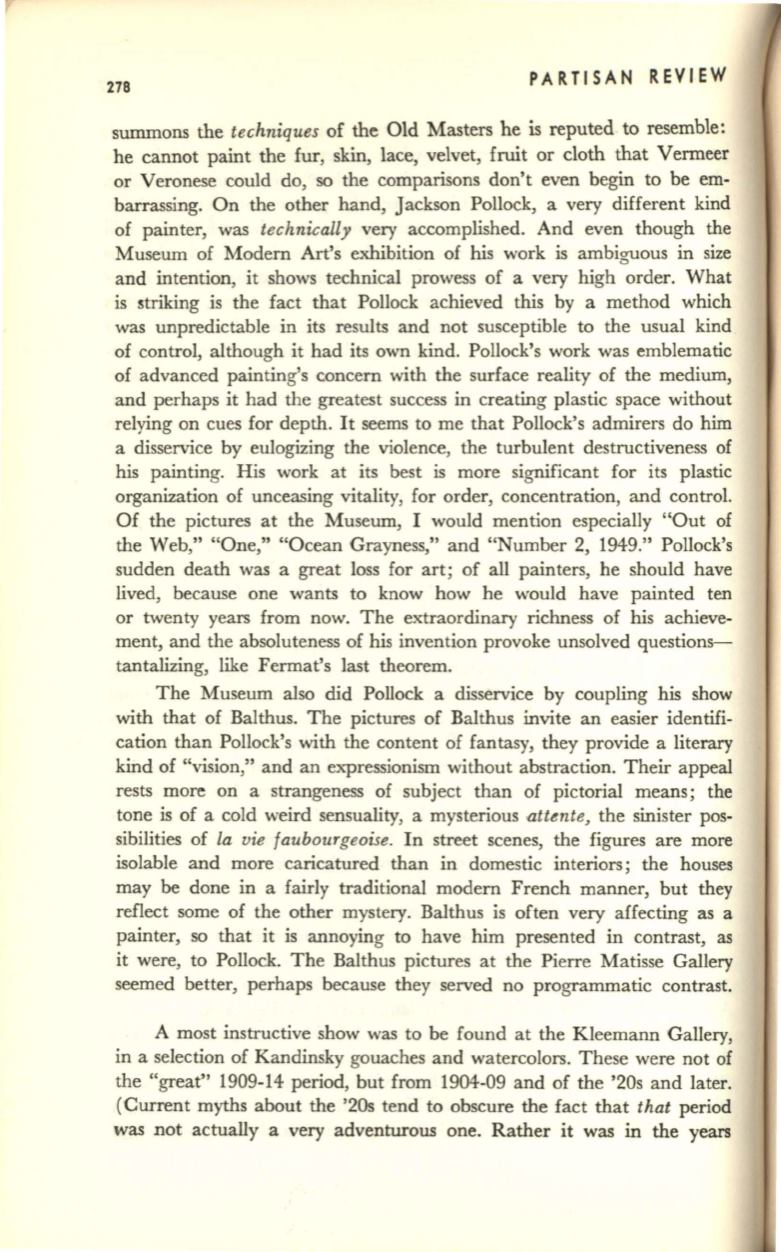
278
PARTISAN REVIEW
summons the
techniques
of the Old Masters he is reputed to resemble:
he cannot paint the fur, skin, lace, velvet, fruit or cloth that Venneer
or Veronese could do, so the comparisons don't even begin to be em–
barrassing. On the other hand, Jackson Pollock, a very different kind
of painter, was
technically
very accomplished. And even though the
Museum of Modern Art's exhibition of his work is ambiguous in size
and intention, it shows technical prowess of a very high order. What
is striking is the fact that Pollock achieved this by a method which
was unpredictable in its results and not susceptible to the usual kind
of control, although it had its own kind. Pollock's work was emblematic
of advanced painting's concern with the surface reality of the medium,
and perhaps it had the greatest success in creating plastic space without
relying on cues for depth. It seems to me that Pollock's admirers do him
a disservice by eulogizing the violence, the turbulent destructiveness of
his painting. His work at its best is more significant for its plastic
organization of unceasing vitality, for order, concentration, and control.
Of the pictures at the Museum, I would mention especially ''Out of
the Web," "One," "Ocean Grayness," and "Number 2, 1949." Pollock's
sudden death was a great loss for art; of all painters, he should have
lived, because one wants to know how he would have painted ten
or twenty years from now. The extraordinary richness of his achieve–
ment, and the absoluteness of his invention provoke unsolved questions–
tantalizing, like Fermat's last theorem.
The Museum also did Pollock a disservice by coupling his show
with that of Balthus. The pictures of Balthus invite an easier identifi–
cation than Pollock's with the content of fantasy, they provide a literary
kind of "vision," and an expressionism without abstraction. Their appeal
rests more on a strangeness of subject than of pictorial means; the
tone is of a cold weird sensuality, a mysterious
attente,
the sinister pos–
sibilities of
la vie faubourgeoise.
In street scenes, the figures are more
isolable and more caricatured than in domestic interiors; the houses
may
be
done in a fairly traditional modern French manner, but they
reflect some of the other mystery. Balthus is often very affecting as a
painter, so that it is annoying to have him presented in contrast, as
it were, to Pollock. The Balthus pictures at the Pierre Matisse Gallery
seemed better, perhaps because they served no programmatic contrast.
A most instructive show was to be found at the Kleemann Gallery,
in a selection of Kandinsky gouaches and watercolors. These were not of
the "great" 1909-14 period, but from 1904-09 and of the '20s and later.
(Current myths about the '20s tend to obscure the fact that
that
period
was not actually a very adventurous one. Rather it was in the years


